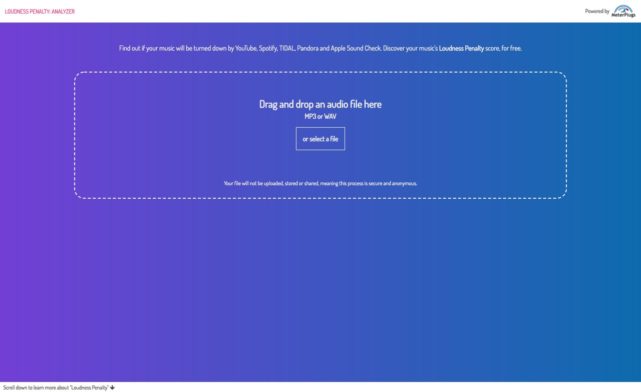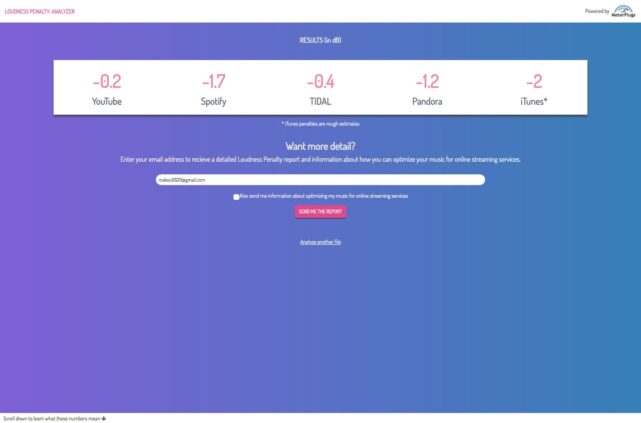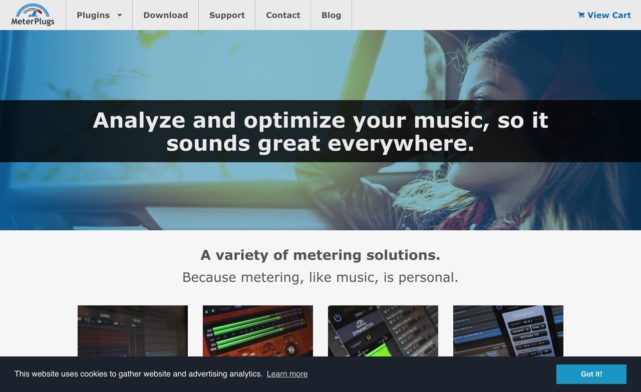名前負けしたバンドっぽい名前 Loudness Penalty ですが、その名の通り、オーディオデータのラウドネスを計測して、YouTubeやSpotify, TIDAL, Pandora, iTunesといった名だたるサービスでどんだけ音量を下げられてしまうかを示してくれるサイト。

作りかけの曲をアップロードしてチェックしてみたら、このようになりました。

で、この後メールアドレスを入力するとまとまった説明と案内メールが送られてきます。
Thanks for using the Loudness Penalty analyzer – here are the results for your file:
***.wav
- YouTube: -0.2
- Spotify: -1.7
- TIDAL: -0.4
- Pandora: -1.2
- iTunes: -2
(*) iTunes penalty values are approximate
■目次
What do these numbers mean?
The Loudness Penalty value tells you how much the playback volume of the track you tested will be changed by each streaming service, in dB (decibels).
So for example, since your track scores LP -0.2 (a negative value) on YouTube, it will be played back 0.2 dB lower than its original loudness when people listen to it there. If the LP was positive, then your song would be played back at its original loudness.
So will my music sound quiet?
Not necessarily. Streaming services turn down loud songs to prevent you being “blasted” by loud music, because it causes complaints. This process is called Loudness Normalization. But their goal is only to get consistent loudness, so your music should just sound a similar level to everything else.
Why do the LP values matter, then?
Since streaming services are going to turn loud music down anyway, more and more people are deciding they would prefer to take control of this process themselves, and optimize their music for the best possible results. The Loudness Penalty values enable you to do this by predicting exactly what will happen to your music when it’s played back after uploading.
If you master something with high loudness, it will be turned down more – you’ll see a larger negative LP score. We recommend avoiding very large negative LP values, especially on YouTube because songs like this often sound “smaller” than those with LP scores closer to zero.
Hear it for yourself
For example, compare the loud sections of these two Metallica songs on YouTube – The Day That Never Comes (LP -5.8) and Hardwired (LP -2.4). Which has more impact?
Loudness normalization means you have the opportunity to make your music sound better, too. In our experience, LP between 0 and -2 on YouTube will work well for even the loudest genres. For example, Drake’s recent hit God’s Plan has a score of LP -0.8 on YouTube, and it sounds huge.
More information
We’ve tried to make the Loudness Penalty site as easy-to-use and intuitive as possible, but this is a complex topic, and there isn’t room to cover all the details here.
If you’d like to take full advantage of the insights Loudness Penalty can give you, we’ve put together a short series of emails telling you everything you need to know about how LP will affect your music, and how to get the best results.
You’ll find out:
- Why LP values are different on each streaming service
- Do the services use compression or limiting?
- What happens with positive LP scores on each service?
- When might you choose to ignore LP values?
- What’s the ideal LP value for maximum playback loudness, and how can you improve the score for your music?
To find out the answers to these questions and more, click here.
どうやらMeterPlugsというメータリングプラグインのメーカーによるサービスのようです。

さんざん今までも語られてきたこと、あと時間もないので全文訳はしませんが、早い話、LP(Loudness Penalty)が0に近い値で見事にミックスされた曲と、ただただ音圧をぶっ込んだ曲を各音楽サービスで鳴らしたときには、当然後者のほうが小さい音量で再生されてしまいパンチもかえってなくなるので、このサイトで示された数値を目安として適正なラウドネス値でガッチリしたミックスを作るよう努めてください、という内容です。
その理屈や技法等を知りたければメールを購読してねということです。